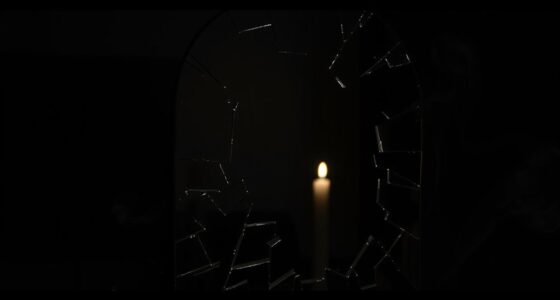Many believe Ouija boards are evil or dangerous, but scientific research shows they’re simply psychological tools influenced by your subconscious. Movements of the planchette often result from the ideomotor effect, not spirits, and media portrayals have exaggerated their risks. Cultural fears and myths fuel the notion of malevolent forces, but rational explanations reveal that the board reflects internal beliefs and expectations. If you’re curious, discover how understanding psychology can change your perspective on the Ouija board.
Key Takeaways
- The belief that Ouija boards are inherently evil is rooted in cultural myths and media portrayals, not scientific evidence.
- Movements of the planchette are caused by subconscious muscle actions, explained by the ideomotor effect.
- Psychological factors like suggestion, expectation, and focus influence perceptions, making experiences seem supernatural.
- Scientific studies show no credible evidence linking Ouija boards to contacting spirits or supernatural harm.
- Recognizing psychological influences can reduce fear, revealing the board as a psychological artifact rather than a malevolent tool.
The Origins and History of the Ouija Board
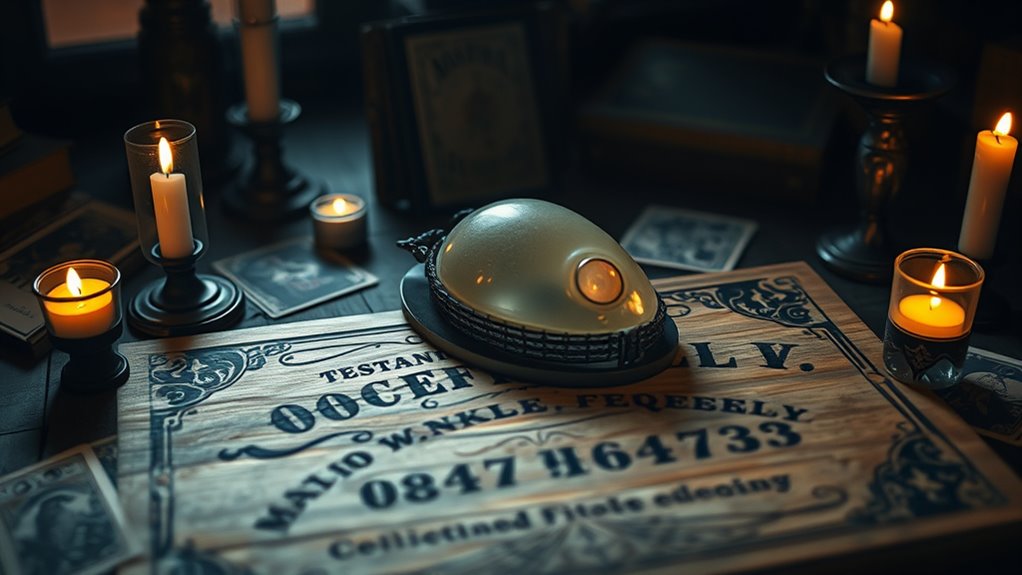
The Ouija board’s origins trace back to the late 19th century, when it was marketed as a mystical tool for communicating with spirits. During this period, its historical origins are rooted in spiritualist movements that sought to connect the living with the dead. The board quickly gained cultural symbolism as a conduit to the supernatural, often associated with mysticism and the occult. People believed it could reveal hidden truths or messages from spirits on the other side. Its popularity grew as a form of entertainment and spiritual exploration. Despite its modern reputation, the Ouija board was initially seen as an innocent device, embedded deeply in cultural symbolism that linked it to the desire for contact beyond the physical world. Additionally, some early designs of the Ouija board incorporated features that enhanced its accuracy, making it more appealing to those seeking reliable communication with spirits.
How the Ouija Board Works: Psychology and the Human Mind
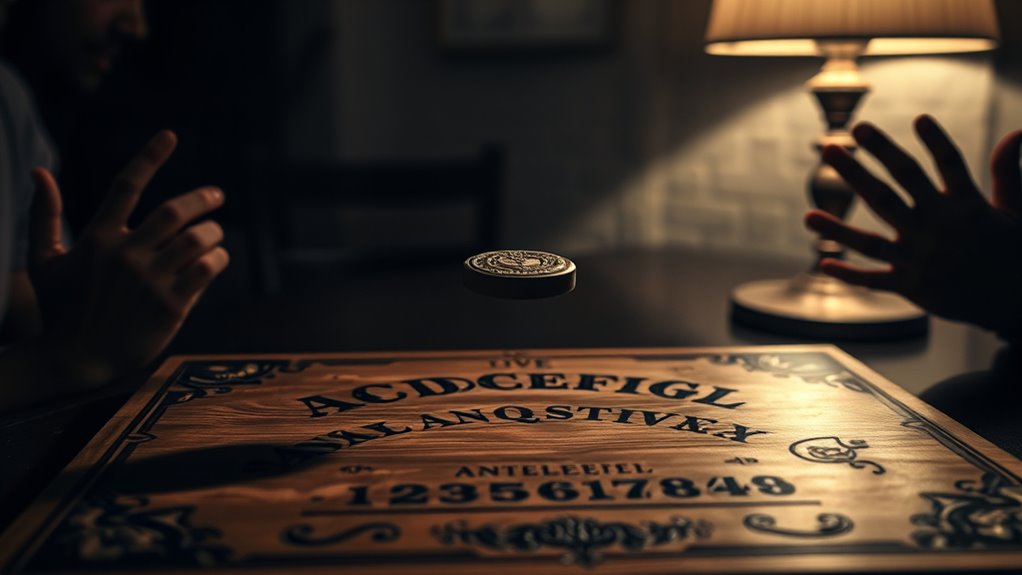
While many believe the Ouija board connects them to spirits, its workings are largely rooted in psychological phenomena. Neuroscience insights reveal that your subconscious influence plays a significant role in how the planchette moves. When you place your fingers on the pointer, your brain subtly guides your hand without you realizing it. This is called the ideomotor effect—a phenomenon where your mind unconsciously causes physical movements. Your expectations, beliefs, and even your desire for answers shape these movements, making it seem like an external force is at work. The power of suggestion and the brain’s tendency to seek patterns also contribute to the experience. Interestingly, this subconscious influence can be strengthened by prior beliefs and emotional states, further reinforcing the illusion of outside forces. Additionally, understanding the psychological mechanisms involved can help demystify the experience and reduce unnecessary fear. Recognizing how perception is shaped by internal processes emphasizes the importance of psychological factors over supernatural explanations. Furthermore, awareness of these cognitive biases can help individuals interpret their experiences more rationally and diminish fear. Recognizing the role of neuroscientific principles in these phenomena can also foster a more informed perspective.
The Role of Suggestion and Expectation in Ouija Sessions
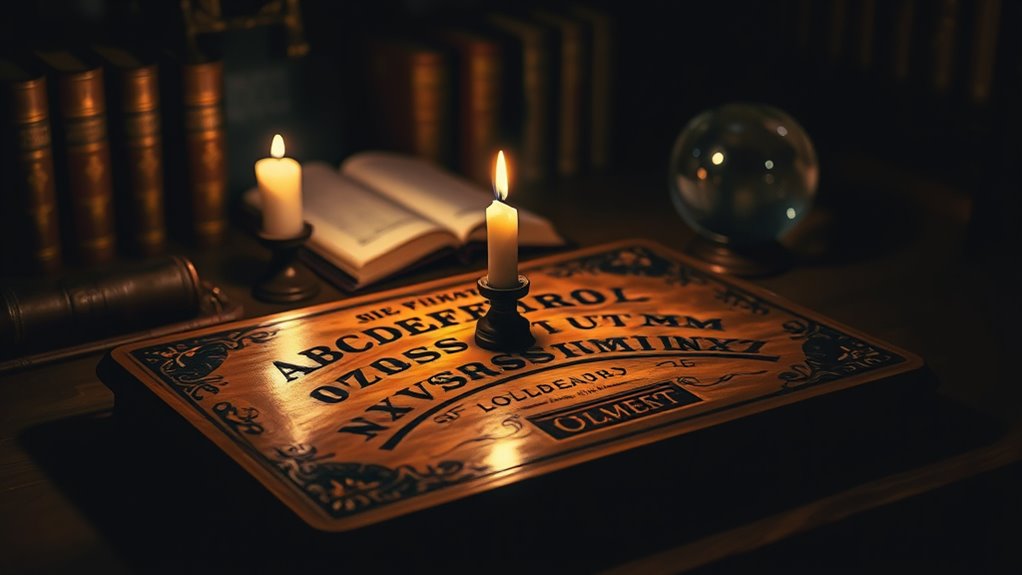
Suggestion and expectation play crucial roles in shaping your experience during Ouija sessions. Your mind is highly susceptible to suggestion influence and expectation bias, which can lead you to interpret movements as meaningful. When you expect a certain answer or believe in spiritual contact, your subconscious may subtly guide the planchette. This effect is reinforced by your focus and emotions, making you more likely to perceive the results as genuine. Factors like prior beliefs, ambient cues, and even subtle physical movements can intensify this influence. Additionally, the use of headphones during sessions can sometimes help mask external noises and reduce distractions, potentially affecting your focus and susceptibility. The perceived presence of spirits may also be heightened by the power of suggestion, which can influence your interpretation of the session. Research in psychology suggests that confirmation bias can further reinforce your expectations, making you more likely to interpret ambiguous cues as confirmation of contact. For example, understanding how psychological susceptibility impacts perception can help clarify why individuals interpret ambiguous stimuli in ways that support their beliefs. Furthermore, expectation bias can cause your brain to fill in gaps with familiar or desired information, creating a convincing illusion of contact. — Your beliefs heighten suggestion influence — Expectation bias skews interpretation — Focused attention increases susceptibility — Ambient cues reinforce beliefs — Subtle physical movements can trigger responses
Cultural Portrayals and Media Influence on Perceptions

Media and cultural portrayals shape how people perceive Ouija boards, often blurring the line between fiction and reality. Movies, TV shows, and books frequently depict them as tools for summoning malevolent spirits, fueling urban legends that paint them as inherently dangerous. These portrayals reinforce cultural stereotypes that associate Ouija boards with evil, possession, or supernatural harm. As a result, many believe they’re more threatening than they truly are, even without firsthand experience. This media-driven narrative influences public perception, making it easy to overlook the historical and cultural contexts that frame the boards as simply a game or a means of entertainment. The widespread media influence has led to exaggerated fears that distort the real nature of Ouija boards and perpetuate unfounded fears.
Common Myths and Misconceptions About Ouija Boards

Many people believe Ouija boards communicate with spirits directly, but often, the messages are misunderstood or misinterpreted. The ideomotor effect explains how your subconscious movements guide the planchette without realizing it. Cultural fears also shape how we view these boards as evil, fueling misconceptions that aren’t based on facts. For instance, some popular dog accessories associated with the holiday season include festive dog sweaters, which are designed for comfort and warmth while adding a fun, seasonal touch. Additionally, the importance of disclosure and transparency in online content helps clarify these myths and promotes a more informed perspective. Being aware of affiliate disclosures and privacy policies can also help consumers make better-informed decisions about the content they consume related to such topics. Understanding scientific explanations behind paranormal beliefs can further demystify these misconceptions and promote rational thinking.
Misinterpreted Spirit Communication
People often believe that Ouija boards reliably communicate with spirits, but in reality, most messages are misinterpreted or caused by subconscious movements. This misunderstanding fuels the myth of a direct spiritual connection, when in fact, many messages result from the ideomotor effect. The board’s movements may seem intentional, but they often aren’t. Common misconceptions include:
- Believing every message is a clear sign from spirits
- Misinterpreting vague or ambiguous responses as meaningful
- Assuming supernatural phenomena are always at play
- Overestimating the board’s ability to reveal hidden truths
- Ignoring psychological influences like suggestion or expectation
These misunderstandings lead people to think Ouija boards facilitate genuine communication with spirits, when most interactions are a product of subconscious cues rather than actual supernatural phenomena.
Role of Ideomotor Effect
The ideomotor effect is a key factor behind many Ouija board movements, yet it’s often misunderstood as supernatural influence. This phenomenon involves psychological mechanisms where your subconscious influences muscle movements without you realizing it. When you place your hands on the planchette, your mind may have subtle expectations or beliefs that cause tiny, involuntary motions. These subconscious influences guide the planchette’s movement, giving the illusion that an external force is at work. It’s important to recognize that these movements are not supernatural but natural responses rooted in your own mind. Understanding the role of the ideomotor effect helps demystify how Ouija boards work, showing they reflect subconscious influences rather than spirits or supernatural entities.
Cultural Fear Influences
Cultural fears and longstanding myths have shaped widespread misconceptions about Ouija boards, often portraying them as portals to the supernatural or gateways to evil. These beliefs are rooted in cultural narratives that emphasize danger and malevolence, fueling societal fears. Such narratives persist through movies, folklore, and religious teachings, reinforcing the idea that Ouija boards invite evil spirits or demonic forces. These misconceptions overshadow the reality that most experiences are psychological or coincidental. To understand the true nature of Ouija boards, it’s essential to recognize how societal fears distort perceptions.
- Popular media depicting Ouija as sinister tools
- Religious teachings linking them to evil
- Folklore associating them with curses
- Cultural stereotypes portraying spirit communication as dangerous
- Societal fears amplifying perceived risks
Scientific Studies and Experiments on Ouija Use

Scientific studies on Ouija boards show no evidence of paranormal activity and often involve controlled experiments that rule out external influences. Psychologists suggest that subconscious movements and expectations explain most of the phenomena users experience. Despite numerous investigations, no credible paranormal evidence has ever been confirmed.
Controlled Laboratory Experiments
Controlled laboratory experiments on Ouija boards aim to determine whether the phenomena reported by users have a scientific basis or result from psychological factors. Researchers explore how psychological manipulation influences outcomes and how cultural conditioning shapes beliefs about spirits. These experiments often reveal that when variables like suggestion and expectation are controlled, the supposed supernatural effects diminish markedly.
- Participants’ beliefs about the supernatural can influence their responses
- Suggestibility plays a key role in perceived phenomena
- When physical cues are minimized, results align with chance
- Cultural conditioning impacts how individuals interpret movements
- Psychological manipulation, such as the ideomotor effect, explains many outcomes
Psychological Explanations Explored
Many studies have investigated how psychological factors influence Ouija board experiences, revealing that what users perceive as supernatural effects often have a scientific explanation. Psychological projection plays a role, as you might unconsciously attribute your own thoughts or feelings to the board. Cognitive biases, like the ideomotor effect, cause subtle movements that seem intentional or paranormal. These biases distort your perception, making you believe you’re contacting spirits when you’re actually influencing the planchette unknowingly. Understanding these mental processes helps explain why Ouija sessions often produce convincing but non-supernatural results. Recognizing the power of your mind can reduce fear and demystify these experiences.
| Psychological Factor | How it Influences Ouija Use |
|---|---|
| Psychological Projection | Attributing personal thoughts to spirits |
| Cognitive Biases | Misinterpretation of movements |
| Ideomotor Effect | Unconscious muscle movements |
| Confirmation Bias | Remembering hits, forgetting misses |
| Expectation Effects | Believing in supernatural outcomes |
Paranormal Evidence Lacking
Despite numerous claims of paranormal encounters during Ouija board sessions, rigorous scientific studies have consistently failed to find evidence supporting supernatural explanations. Researchers have tested whether psychic phenomena or spiritual communication occur through controlled experiments, but results remain inconclusive. Skeptics argue that the movements attributed to spirits are simply the ideomotor effect, a subconscious muscle response. To date, no credible scientific study has demonstrated that Ouija boards facilitate actual contact with spirits or supernatural entities. Instead, findings suggest that psychological factors, such as suggestion and expectation, influence user experiences. Without reliable evidence, the idea that Ouija boards serve as portals to otherworldly communication remains unsubstantiated. The absence of scientific validation undermines claims of paranormal activity associated with Ouija use.
The Risks and Safety Concerns Often Cited

Have you ever wondered what dangers might come with using a ouija board? Many cite concerns about psychological safety, fearing that engaging with the board could lead to anxiety, depression, or even unintentional psychological effects. Some believe it might open doors to negative energies or spirits, though these claims lack scientific backing. Cultural stigma also plays a role, as many societies associate ouija boards with evil or dangerous practices, reinforcing fear and avoidance. However, these safety concerns are often rooted in superstition rather than evidence. For most users, the main risk is the potential for emotional distress if they believe in the board’s power. Understanding these fears helps separate myth from reality, emphasizing that the real risk lies more in perception than actual danger.
Why Fear and Superstition Persist Around the Board
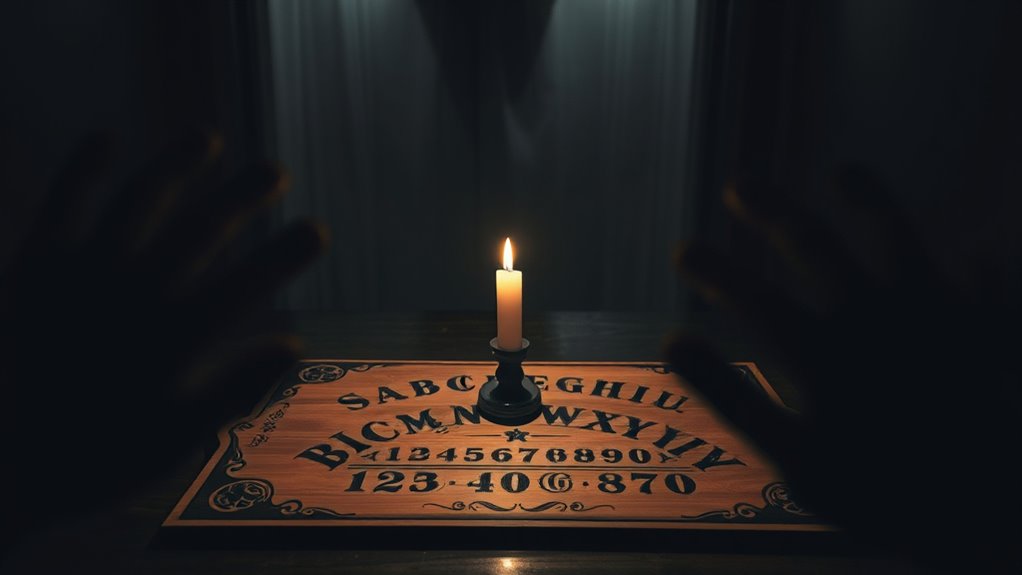
Superstitions and cultural narratives have kept fears about ouija boards alive long after scientific explanations have debunked many concerns. These beliefs persist because they tap into deep-seated fears of the unknown and the supernatural. Cultural fear is reinforced through stories, movies, and media that depict the board as dangerous or evil. Superstition persistence is fueled by psychological factors like the ideomotor effect, which makes it seem like spirits are moving the planchette. Additionally, societal taboos around death and communication with spirits heighten anxiety. These elements create a cycle where fear is reinforced, making it difficult for rational explanations to take hold. As a result, the cultural fear surrounding ouija boards remains strong, despite scientific debunking.
Reconsidering the Board: A Rational Perspective

When you look at ouija boards through a rational lens, they lose much of their ominous reputation. The movements often attributed to supernatural forces are better explained by psychological mechanisms like the ideomotor effect, where your subconscious influences your actions without awareness. Cultural biases also play a significant role, shaping beliefs that the board is inherently evil. These societal fears reinforce the idea that the board holds supernatural power, making it seem more sinister than it really is. By understanding the psychological and cultural factors at play, you can see the ouija board as a tool that reflects human psychology rather than a portal to the supernatural. This perspective encourages skepticism and rationality, helping you reconsider the fear that surrounds the board.
Frequently Asked Questions
Can Ouija Boards Be Used for Legitimate Communication With Spirits?
You might wonder if Ouija boards can genuinely connect you with spirits. While some believe in their spiritual authenticity, many psychic claims lack scientific backing. It’s important to approach these tools with skepticism and understand they often rely on subconscious cues or suggestion. If you seek true communication with spirits, consider consulting experienced mediums rather than relying solely on a Ouija board, which doesn’t guarantee legitimate contact.
Are There Any Proven Psychological Effects Caused by Ouija Board Use?
Think of your mind as a garden—use it carelessly, and weeds sprout; tend it well, and flowers bloom. When you use a Ouija board, it can trigger psychological effects like anxiety or suggestibility, impacting your mental health. These effects aren’t proven to be caused directly by spirits but by psychological processes like the ideomotor effect. Be mindful, as your mental health can be influenced by your expectations and beliefs.
How Do Different Cultures Perceive and Use Ouija or Similar Tools?
Different cultures view and use Ouija or similar tools through diverse lenses. In some traditions, these tools are part of spiritual rituals, helping connect with ancestors or spirits, while others see them as cultural taboos linked to superstition or danger. You might find that in certain societies, using such tools is accepted and respectful, whereas in others, it’s avoided to prevent offending spiritual beliefs or breaking cultural taboos.
What Are the Legal Implications of Owning or Using a Ouija Board?
You might worry about legal restrictions on owning or using a Ouija board, but generally, it’s legal in most places. Ownership rights are clear—you can buy, own, and use one for entertainment or spiritual exploration. Just check local laws, as some areas may have restrictions. Be responsible and respectful, and you won’t face legal issues. Remember, understanding local regulations helps you stay within the law while exploring your interests.
Has Scientific Research Conclusively Proven Ouija Boards Are Supernatural?
You might wonder if scientific research has conclusively proven ouija boards are supernatural. Currently, no scientific evidence confirms this. Instead, studies highlight the psychological impact, like the ideomotor effect, influencing user responses. Cultural beliefs also shape perceptions, making some see supernatural forces at work. While intriguing, these factors suggest ouija boards are more about perception and psychology than proven supernatural phenomena.
Conclusion
So, next time you hear whispers of danger surrounding the Ouija board, remember it’s mostly your mind playing tricks. The truth isn’t as spooky as stories suggest—yet something remains unresolved. Could there be more to these boards than science admits? Or is the real mystery hiding in your own expectations? Whatever the answer, one thing’s certain: the secret isn’t fully out, and the truth might be closer than you think.


